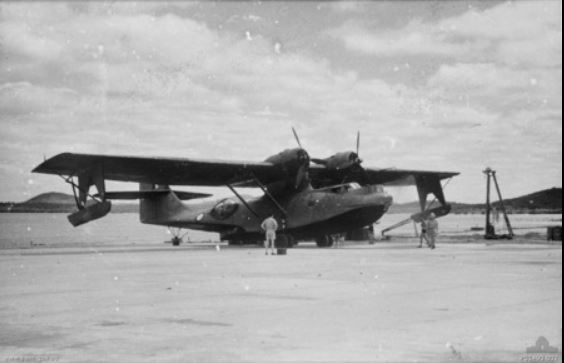No. 11 Squadron RAAF
From Our Contribution
 NO 11 Squadron Catalina beached for Maintenance in 1943. AWM P01490002 |
Contents
[hide]Brief History
No. 11 Squadron was established on 25 Sep 1939 at RAAF Base Richmond, equipped with two Supermarine Seagull V aircraft and two Short Empire flying boats. On 28 Sep 1939, the squadron deployed to Port Moresby from where it monitored Japanese shipping movements. The squadron received another two Empires as it sought to expand its operations to places such as Thursday Island and Bougainville. The squadron was re-equipped with six Consolidated PBY Catalina aircraft in 1941, before transferring some of its aircraft to No. 20 Squadron in late November.
Following the outbreak of war with Japan in December 1941, No. 11 Squadron began flying long range patrol missions across the South West Pacific area, lasting up to 20 hours in duration. These would continue throughout the war. It undertook patrols and occasional raids against Japanese targets, supplemented by evacuation and repatriation of both military and civilian personnel back to Australia. On 7 May 1942, following Japanese air attacks on Port Moresby, the squadron was withdrawn to Australia, arriving in Bowen, Queensland from where it flew reconnaissance sorties in support of Allied naval operations during the Battle of the Coral Sea. Throughout the remainder of 1943, the squadron undertook anti-submarine and anti-shipping patrols, along with bombing missions in New Guinea during which one Catalina was lost.
The squadron moved to Cairns on 11 Nov 1942, and began to attack Japanese supply convoys moving between Lae and Finschhafen. In early March 1943, aircraft from No. 11 Squadron took part in the surveillance of the Japanese convoy which was destroyed in the Battle of the Bismarck Sea. From April 1943 until the end of the war, No. 11 Squadron performed offensive mine-laying operations, including mining Manila harbour in December 1944. This feat required three aircraft to fly over 14,500 kilometers in the RAAF's longest mission of the war with the Squadron now based at Rathmines in NSW.
The squadron spent the final months of the war conducting mine laying operations, including Balikpapan Harbour. After Japan surrendered in August 1945, its focus shifted to humanitarian efforts, air dropping supplies to Allied personnel in prisoner-of-war camps, and repatriating newly liberated POWs back to Australia. These operations continued until the end of 1945 when it was withdrawn back to Australia. The Squadron ceased to exist on 15 Feb 1946. Casualties during the war amounted to 94 personnel killed.
On 1 July 1948, No. 11 Squadron was re-formed at RAAF Base Rathmines, operating Catalinas again, tasked with undertaking search and rescue sorties as well as courier tasks. In September that year, the squadron lost one aircraft in a crash on Lord Howe Island during a night navigation exercise, resulting in the deaths of seven of the nine crew members. The squadron ceased operations on 1 May 1950 and was briefly disbanded between then and 1 Nov 1950, when it re-formed at RAAF Base Amberley in Queensland. It was now operating modified Avro Lincoln heavy bombers, and on 12 Nov 1950 it was transferred to RAAF Base Pearce in Western Australia, from where it conducted patrols over the Indian Ocean. It was re-equipped with Lockheed P-2 Neptune aircraft throughout 1951–53, sending crews to the United States to fly the aircraft back, and in May 1954 the squadron relocated to RAAF Base Richmond.
Battle Honours
- Coral Sea
- Darwin 1941-1944
- Dutch New Guinea
- Moresby 1942-1943
- New Britain 1943
- New Guinea 1942-1944
- New Guinea 1943-1944
- Pacific 1941-1945
- Rabaul 1942
Individual Honours
- 2 x Distinguished Service Orders
- 13 x Distinguished Flying Crosses
- 3 x Air Force Crosses
- 13 x Distinguished Flying Medals
- 1 x British Empire Medal
- 8 x Mentioned in Despatches
Squadron personnel
Air Crew
- † John Gordon Nicholson 27 Jun 1941 - 27 Feb 1942
Groundcrew
- Alfred Ensor Hand July 1951 - 12 May 1954
Notes